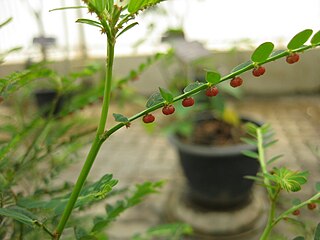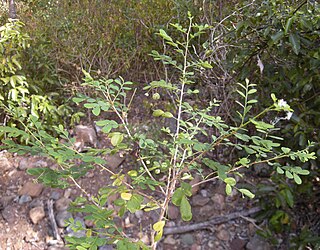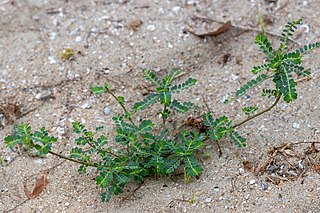
The stamen is the pollen-producing reproductive organ of a flower. Collectively the stamens form the androecium.

Phyllanthus is the largest genus in the plant family Phyllanthaceae. Estimates of the number of species in this genus vary widely, from 750 to 1200. Phyllanthus has a remarkable diversity of growth forms including annual and perennial herbs, shrubs, climbers, floating aquatics, and pachycaulous succulents. Some have flattened leaflike stems called cladodes. It has a wide variety of floral morphologies and chromosome numbers and has one of the widest range of pollen types of any seed plant genus.

Phyllanthaceae is a family of flowering plants in the eudicot order Malpighiales. It is most closely related to the family Picrodendraceae.

Phyllanthus urinaria, commonly called chamber bitter, gripeweed, shatterstone, stonebreaker or leafflower, is a species of suffruticose and herb in the family Phyllanthaceae.

Phyllanthus acidus, known as the Otaheite gooseberry, Malay gooseberry, Tahitian gooseberry, country gooseberry, star gooseberry, starberry, arbari, West India gooseberry, or simply gooseberry tree, is one of the trees with edible small yellow berries fruit in the family Phyllanthaceae. Despite its name, the plant does not resemble the gooseberry, except for the acidity of its fruits. It tastes sour and tart.

The genus Sauropus, of the family Phyllanthaceae, comprises about 40 species of herbs, shrubs or subshrubs, sometimes with woody bases. These plants can be monoecious or dioecious. They are distributed in Southeast Asia, Malesia and Australia.

Phyllanthus emblica, also known as emblic, emblic myrobalan, myrobalan, Indian gooseberry, Malacca tree, or amla, from the Sanskrit आमलकी (āmalakī), is a deciduous tree of the family Phyllanthaceae. Its native range is tropical and southern Asia.

Phyllanthus anamalayanus is a species of plant in the family Phyllanthaceae. It is endemic to the Anamalai Hills in Coimbatore district in the state of Tamil Nadu, India. The species is a shrub or small tree occurring in the understorey of mid-elevation tropical wet evergreen forests in the Anamalai Hills, and is endemic to the Western Ghats. It is threatened by habitat loss.

Oplismenus is a small genus of annual or perennial grasses, commonly known as basketgrass, found throughout the tropics, subtropics, and in some cases, temperate regions of the Americas, Africa, Asia, and Australia. The systematics of the genus are unclear, with over 100 described species, only 7 species are officially recognized as of 2016.

Pilumnus hirtellus, the bristly crab or hairy crab, is a species of European crab. It is less than 1 inch (25 mm) long and covered in hair. It lives in shallow water and feeds on carrion.

Phyllanthus microcladus is a plant found in sub tropical areas of eastern Australia. The brush sauropus is listed as endangered by extinction. It occurs by streams in sub tropical rainforest, from as far south as Grafton, New South Wales to the south east rainforest areas of Queensland. Most often seen in the valleys of the Brunswick, Richmond and Tweed Rivers in far north eastern New South Wales.

Epiphyllum phyllanthus, commonly known as the climbing cactus, is a species of epiphytic cacti. It has no leaves, instead having stems that photosynthesise. It is thought to be pollinated by hawkmoths, as the flowers only open at night and produce a strong fragrance.

Phyllanthus niruri is a widespread tropical plant commonly found in coastal areas, known by the common names gale of the wind, stonebreaker or seed-under-leaf. It is in the genus Phyllanthus of the family Phyllanthaceae.

Oplismenus hirtellus is a flowering perennial plant from the family Poaceae that can be found on every continent in the world except Antarctica, growing mostly in coastal tropic and subtropic regions as well as tropical and subtropical islands such as Hawaii, New Zealand, Australia and Madagascar.

Oplismenus undulatifolius, commonly known as wavyleaf basketgrass, is a species of perennial grass from the family Poaceae that is native to Eurasia, specifically Southern Europe through Southern Asia. Due to its invasive nature, it can be found in countries such as Pakistan, China, Japan, Korea, India, Australia, South Africa, and has since been introduced to the Mid-Atlantic United States. There are no recognized subspecies in Catalogue of Life.

Phyllanthus balgooyi is an herbaceous plant in the family Phyllanthaceae, found in Palawan and Sabah. The plant is a hyperaccumulator of nickel, with a concentration of the metal exceeding 16% in the plant's phloem sap.

Securinine is an alkaloid found in Securinega suffruticosa and Phyllanthus niruri.

Phyllanthus amarus is a leafy herbal plant found in tropical regions in the Americas, Africa, India, China and South East Asia. Commons names for this plant include gale of the wind, carry me seed, seed on the leaf, pick-a-back, Bhuiavla (Hindi), Bhuiamla (Bengali), stonebreaker, dukung anak (Malay).

Phyllanthus fluitans, also known as the red root floater, floating spurge, or apple duckweed is a species of free floating aquatic plant and herbaceous perennial in the family Phyllanthaceae. This species is one of the only three non-terrestrial species in the genus Phyllanthus, with the other species being P. leonardianus and P. felicis. The generic name comes from Ancient Greek meaning leaf or a leaf flower, and the specific name comes from Latin meaning floating or float. It was described in March 1863 by George Bentham and Johannes Müller Argoviensis.



















